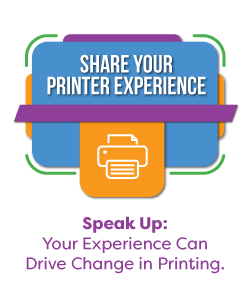Printing Standards Explained (ISO/IEC 19752:2017, ISO/IEC 19798 and others)
Posted by Dunja Djuragic on 12/30/2022

Most widely available printers on the market are quite good at what they do. We have international printing standards to thank for that!
ISO standards regulate service and product quality across industries, print included. It’s the reason you can compare printer speed, yield, and quality in tangible terms and between manufacturers.
Besides creating guidelines for production, ISO standards help brands report performance in straightforward terms.
To help you use this information to your advantage, we created an overview that covers all the most important printing industry standards. Let’s dive in!

Why Standards Matter in Printing
At some point, everybody asks this question: “How do I choose the right printer for me?”
The simple approach is to take a moment to figure out your real printing needs, and consider the price-quality ratio. Go for a multifunctional workhorse if you’re in a busy office or invest in a good photo printer if you’re an artist. Simple as that.
For most users, this is enough information to get a suitable device. However, if you want to take a deep dive into the market and truly compare printers, read up on standards.
All recognized printer manufacturers use international standards when developing their products, and later for quality control and testing. This is important because it ensures that:
- Print shops produce consistent and predictable quality prints, no matter which print technology they use.
- Your home or office printer (and its cartridges) predictably put out a number of prints that meet certain standards.
- You have access to detailed reports with metrics that help you determine the real quality and efficiency of printer models.
Technical documentation is easily available for any printer on the market, you just need to know how to decipher it.
A great place to start is learning the vocabulary behind graphic technologies. The industry had centuries to develop, so printing terms can be confusing at times.
Luckily, even the vocabulary and symbols used in printing are standardized - by documents ISO 12637 and ISO/TR 15847 respectively!

ISO standards are a way to ensure consistent and predictable quality in all areas of printing.
What are ISO standards?
Standards have the goal to create universal guidelines for manufacturing across the globe.
By far, the best-recognized organization for standardization in the world is ISO. Almost every industry has a few sheets of ISO standards defined and widely used.
ISO standards typically define general guidelines, specifications, and methods or processes that provide optimum results in a certain category. Simply put, ISO Compliance is a sort of quality guarantee.
The International Organization for Standardization (ISO) has its central quarters in Geneva, Switzerland, but its members come from over 160 countries.
The organization has published almost 25,000 standards across industries since its foundation in 1946. Along with ISO, you’ll come across the abbreviation IEC too.
The International Electrotechnical Commission often works hand-in-hand with ISO to create all-encompassing standards and publications.
Printing Industry Standards and Specifications
Print Speed Standards
When you only print a few sheets per week, speed is not an issue. But in an office, you shouldn’t wait 20 minutes to get that documentation.
That’s why you should pay attention to ISO/IEC 24734 and ISO/IEC 24735 - the printing and copying speed standards.
The actual printing time depends on many factors including software, print mode, and document complexity. ISO/IEC 24734 defines parameters for testing speed across devices, so you can compare apples to apples.
Among other things, the standard defines a set of pages to be printed and timed on every tested device, using a few formats (including Word, Excel, and Adobe Reader files).
The time needed to print all documents may be expressed directly (under the category FSOT - First Set Out Time).
But more often, it’s listed under the Effective Throughput category expressed in average values in PPM - pages per minute or IPM - images per minute.
Cartridge Yield Standards
Whenever you need to get a new cartridge for your printer, you need to make an important decision: Get a standard cartridge, or pay more upfront for one that can print more pages?
It’s incredible but it’s true - two cartridges that fit in the same printer and have the same size can have dramatically different printing yields.
Standard toner cartridge may yield 1,500 while a high-yield may get you up to 7,000 pages on average.
To make those numbers comparable across brands and cartridge models, ISO created a set of procedures and test pages that are used when testing and reporting cartridge yield.
- ISO/IEC 19752 for monochrome (black only) laser printer toner cartridges.
- ISO/IEC 19798 for color laser printers and multifunctional machine toner cartridges.
- ISO/IEC 22505 for monochrome inkjet printer cartridges.
- ISO/IEC 24711 for inkjet color printers that use ink cartridges and
- ISO/IEC 29102 special guideline for cartridge yield in photo printers.
This number lets you reasonably accurately predict how much printing each page costs with a certain cartridge!

Color toner cartridge yield is usually displayed on the box and the manufacturer’s website.
Color and Image Quality Standards
There are quite a few important factors for your printer to give you a reliably brilliant image that lasts a long time.
Toner or ink in your cartridge needs to be of reliable quality, your digital files properly exchanged and reproduced, color properly calibrated, and so much more. Here are some of the important printing quality standards:
- ISO/IEC TS 24790 - Defines how to measure image quality for black and white text and images printed with office printing devices.
- ISO/TS 15311 (especially part 2) - Helps print buyers assess their commercial print, whether on paper or packaging like plastic, at a viewing distance between 30 and 50 cm.
- ISO/PAS 15339 - Ensures the color characteristics stay correct throughout the printing process.
- ISO/TS 10128 - Defines the best ways to adjust color, aka how to best prepare your digital files for print. ISO 12639 and ISO 12640 are related standards that deal with prepress data exchange, digital formats, and CMYK formatting.
- ISO 2834 and ISO 2836 - These documents assess the colorimetry and optical density of the pigments, as well as the resistance of printing colors to mechanical damage and various agents like solvents, varnishes, and acids.

Related Standards in Conventional Printing
When we talk about printing here at TonerBuzz, we usually mean digital printing.
But office multifunctional laser machines and home-use inkjets are far from the largest chunk of the printing industry.
Conventional printing encompasses many technologies, the most widespread being offset, screen, gravure, and flexo printing. Those are the big machines print shops use for a lot of commercial printing.
As you can guess, many standards were developed for complex printing machines, but ISO 12647 is by far the most often cited.
- ISO 12647 - This standard defines processes and color standards for different types of printing. It deals with metrics like the transparency of inks, tone value increases, suitable paper types, and processes like half-tone color separations.
- This exhaustive document covers standards in different printing techniques, and as of recently, the related ISO 12647-2 is gaining more traction in digital printing - it’s a unique opportunity to ensure digital printing matches up to offset print quality.
Printing Paper Standards
Great pigments, printing speeds, and yields don't mean much if you don't have a good surface for your print. Help decrease deforestation - be mindful of each document you print!
Regular copy paper will work for your office documents, but if you want to store a document for a long time or need to convey paper quality to your print professional, these ISO standards may come in handy:
- ISO 9706 - Defines the properties and chemical structures of papers that are known for their permanence and resilience. Important for archival paper.
- ISO 15397 - This standard discusses communication of graphic paper properties used in heat-set web offset, cold-set web offset, sheet-fed offset, rotogravure and flexographic printing processes.

Did you know most printing paper is delivered and used in rolls?
Ecology and Printing Standards
Finally, no successful industry in the 21st century can go far without regulating its impact on the environment.
- ISO 14001 has an impact on a vast array of industries, including printing. It regulates many aspects of waste and environmental management.
- ISO 22067 covers proper communication of the environmental aspects within the printing industry supply chain. This is an all-encompassing document that specifies environmental communication requirements across printing techniques and industries, except for print on textiles and ceramics.
- ISO 20690 deals with the power consumption in digital printers. This standard covers electricity usage in different operating modes and takes into account both small- and wide-format printers.
- ISO/IEC 28360 is an information technology standard that regulates chemical emission rates from electronic office equipment.
Bring Your Printing Up To Standard
Printing is a large and ever-evolving industry. With new technologies and trends, new brands and models appear on the market every day - and as a customer, you want to make sure you get your money’s worth.
Knowing that your printer is certified and tested according to these ISO standards is a sure sign you’re on the right track!
P.S. - Always hold your prints up to a higher standard. If your printer is streaking or skipping lines, a new cartridge might be just what the doctor ordered!









